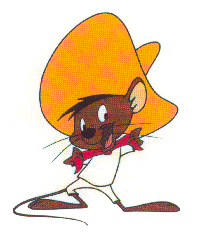
Bibliography
References
Artze, Isis. Hispanic Heritage Plaza 2004. [http://www.hispaniconline.com/hh04/culture/building_character.html] December, 2005
This website gives descriptions of many positive Latino cartoons that have been or are becoming popular, including Dora the Explorer, Baldo, and Gordo. The website is designed to promote awareness of Latinos’ contributions, achievements, and traditions via the
media, organizations, and links to other similar websites.
Berg, Charles R. 2002. Latino Images on Film: Stereotypes, Subversion, and
Resistance. 1st ed. Vol. 1. Austin: University of Texas Press.
This book gives an unique point of view on the stereotypes that have remained in U.S. popular culture. We used this book to obtain a better understanding of Latinos in a different form of media.
Black, George. 1988. GOOD NEIGHBOR (New Look at History). 1st ed.Pantheon.
This book was mainly used to obtain the images from the 19th Cenutry Gallery.
Castellanos, Luis Maria. MiGente.com.
[ http://www.migente.com/Members/?LAUNCH_PAGE=http%3A//www.migente.com/Members/Channels/frameset.html%3FID%3D3865%26CATID%3D1 ] December, 2005
The www.migente.com website is meant to connect Latinos through various means, including chatting with romantic possibilities and giving new coverage of the latest stories that affect Latinos. This article interviewed the creators of ¡Mucha Lucha! to hear their take on the show’s success, its history, and its purpose.
Entman, Robert M., and Rojecki, Andrew. 2001. The Black Image in the White Mind: Media and
Race in America. 1st ed. Chicago: University Of Chicago Press.
This book offers a comprehensive look at the complex racial patterns in the mass media and how they shape the conflicting attitudes of Whites toward Blacks. Although it illustrates the conflict between African Americans and Caucasians, it provides an interesting reflection on race relations in general.
Kuntz, Tom. Puerto Rico Herald. [http://www.puertorico-herald.org/issues/2002/vol6n16/Speedy-en.shtml] November, 2005
There are two articles on this page of the Puerto Rico Herald that give the two sides of
the debate on Speedy Gonzales’ removal from daytime television. The first article gives
criticism of this removal whereas the second article is strongly against Speedy and what
he stands for.
Lester, Paul. 2003. Images That Injure: Pictorial Stereotypes in the Media. Praeger
Greenwood. 2nd ed. Connecticut: Praeger Paperback.
Lester illustrates the damaging effects of stereotypical images in various media outlets. We used this book for basic background information on stereotypical images and how they are implemented and used by mainstream and independent media.
Marktein, Don. Toonpedia. [http://www.toonopedia.com/speedyg.htm] [http://www.toonopedia.com/gordo.htm]November, 2005
These websites are part of a large online encyclopedia of cartoons and cartoon
characters. Each website describes the specific cartoon it says (Speedy or Gordo),
including who distributed the cartoon, the name of the cartoonist, the year it was first
published, and a history of the cartoon itself.
Noriega, Chon A., and Lopez, Ana M., eds. 1996. The Ethnic Eye: Latino Media Arts. University of
Minnesota Press. 1st ed. Minnesota: University of Minnesota Press.
Noriega and Lopez offer a collection of works by Latino and Anglo authors that speak to the representation of Latinos themselves in popular media, independent art, and other forms of modern expression.
Park, Michael Y. FOXNews.com. [http://www.foxnews.com/story/0,2933,48872,00.html] November, 2005
This article explains why Speedy Gonzales was taken off air and gives both arguments for
supporters and opponents of this action taken by the Cartoon Network. It gives some
history of Speedy’s success as well as recent criticism of him too.
Rodriguez, Clara E. 1997. Latin Looks: Latino Images in the Media. Westview Press. Boulder,
Colorado. 1st ed.Westview Press.
Rodriguez outlines not only the typical diatribe on Latino stereotypes in the media but also shows how it changes over time and how it is influenced by American-Latin American political relations.
Tucker, Ken. Entertainment Weekly. http://www.ew.com/ew/article/review/tv/0,6115,345186~3|71826~,00.html December, 2005
This brief article gives a short history of ¡Mucha Lucha! and how it has been doing thus
far with the ratings (which have been extremely high). It is reviewed by Ken Tucker, who
gives the show a grade 'A'.
Webmaster Unknown. Speedy Gonzalez.[http://www.bostonbrace.com/images/speedygonzales.gif] December, 2005
This website was used for the gif image of speedy seen throughout the site. it is a registered trademark of Waner Bros. Permission Pending.
Webmaster Unknown. Dora the Explorer Wood Magnet .[http://www.emerchandise.com/product/MTDOR0002/s.Xs5NKkXK] December, 2005
This website was used for the gif image of speedy seen throughout the site. it is a registered trademark of Nickelodeon. Permission Pending.
Webmaster Unknown. Baldocomics.com. [
http://www.baldocomics.com/index.php ] December, 2005
This website it dedicated to the Baldo comic strip. It has the latest updates, new
archive, history of the creators, and a Baldo store.
Webmaster Unknown. CNN.com. [http://cnnstudentnews.cnn.com/2001/fyi/lesson.plans/09/10/bel.hernandez/] December, 2005
This article interviewed Bel Hernandez, the co-founder of LATINEHAT, a magazine that
focuses solely on Latinos in all forms of industry in the US. CNN.com asked her questions
regarding Latinos in the media and entertainment industry.